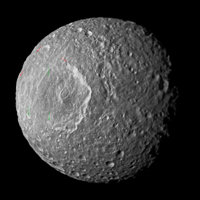
Click on the image for larger annotated versionRelatively dark regions below bright crater walls and streaks on some of the walls are seen in this mosaic of Saturn's moon Mimas, created from images taken by NASA's Cassini spacecraft during its closest flyby of the moon. The crater floors and surroundings are about 20 percent darker than the steep crater walls in this view.
Mimas' original surface, like the surfaces of most of the other major Saturnian moons without atmospheres, is not pure ice but contains some dark impurities.
The relatively dark markings appear along the lower portion of the walls of Herschel Crater (130 kilometers, 80 miles wide) and some of the smaller craters and are marked in green in the annotated version of the image. Cassini scientists interpret this darkening as evidence for the gradual concentration of impurities from evaporating icy materials in areas where the dark impurities slide slowly down the crater wall. There, the bright ice is baked away by the sun and the vacuum of space. At Herschel, the edge where the darker regions contact the crater floor is interrupted by an extensive hummocky area. Scientists believe the hummocky texture came from the flow of melted ice that occurred during the impact that created the crater. That melt filled the bottom of the crater around the central peak.
Dark streaks are seen making their way down the sides of some craters (marked red in the annotated version) and often originated from pockets of dark contaminants embedded just below the rim of the crater wall. The pockets themselves likely represent small, pre-existing, dark-floored craters that were buried by the blanket of material thrown out from the newer impact that created the crater rim. The material from newly exposed dark layer eventually moves downslope and forms a streak. Streaks sometimes are seen starting from the floors of smaller dark-floored craters perched along rims of larger craters.
The interior of Herschel Crater is significantly less cratered than the continuous ejecta blanket that extends radially outward from its rim. The violent meteor impact that excavated Herschel blasted pulverized debris, including massive chunks of ice, upward. The fallback of this ejected material over the crater rim created a thick debris blanket and dotted it with secondary craters. The presence of a fluid pool of melted material on the crater floor, which solidified after the debris fell, probably explains the relative absence of craters on Herschel's floor. These are common processes that should occur on airless bodies throughout the solar system. They may be accentuated on Mimas because of the large size of Herschel in comparison to Mimas' size.
Cassini scientists also continue to study a color anomaly on Mimas. See PIA12572 and PIA06257 to learn more.
Cassini came within about 9,500 kilometers (5,900 miles) of Mimas during its flyby on Feb. 13, 2010. This mosaic was created from seven images taken that day in visible light with Cassini's narrow-angle camera. An eighth, lower-resolution image from the same flyby, taken with the wide-angle camera, was used to fill in the right of the mosaic. The images were re-projected into an orthographic map projection. This view looks toward the hemisphere of Mimas that leads in its orbit around Saturn. Mimas is 396 kilometers (246 miles) across. The mosaic is centered on terrain at 5 degrees south latitude, 85 degrees west longitude. North is up.
This view was acquired at a distance of approximately 16,000 kilometers (10,000 miles) from Mimas and at a Sun-Mimas-spacecraft, or phase, angle of 46 degrees. Image scale is 90 meters (295 feet) per pixel.
The Cassini-Huygens mission is a cooperative project of NASA, the European Space Agency and the Italian Space Agency. The Jet Propulsion Laboratory, a division of the California Institute of Technology in Pasadena, manages the mission for NASA's Science Mission Directorate in Washington. The Cassini orbiter and its two onboard cameras were designed, developed and assembled at JPL. The imaging team is based at the Space Science Institute, Boulder, Colo.
For more information about the Cassini-Huygens mission visit http://www.nasa.gov/cassini and http://saturn.jpl.nasa.gov. The Cassini imaging team homepage is at http://ciclops.org.

